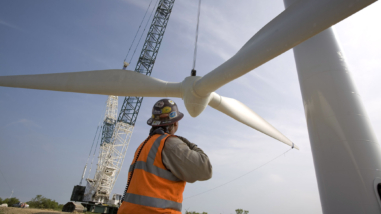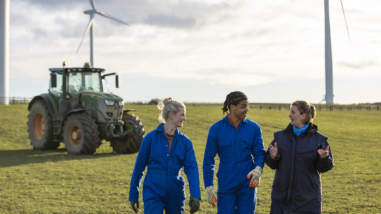Building a sustainable and just future: Q&A with Anup Bandivadekar
So you are choosing to look at the opportunities offered by addressing climate change, not solely the challenges. What are some areas where you see the most promise?
Electrification of transportation is creating opportunities to address historical problems with the way transportation has worked and reimagine ways it could work in the future.
One of our partner organizations is Moving Forward Network (MFN), a collective of more than 50 grassroots organizations from around the United States fighting for clean air in their communities. Communities that are port adjacent, highway adjacent, warehouse adjacent — that for decades have borne the brunt of diesel emissions at their doorsteps.
Moving Forward Network is making a strong case not just for zero-emission trucks but zero-emission rail yards, zero-emission airport terminals, preventing expansions of highways that exacerbate air quality problems. Zero-emission trucks are still at the early stages of their deployment; what our partners are doing is to get the earliest deployment of zero-emission truck technologies in areas that have traditionally borne the brunt of heaviest air pollution from diesel trucks. It’s just one example of the kind of opportunity that is going to allow us to make the transportation system work not just in a cleaner way, but a slightly more just way.
Another one of our grantee partners, Clean Energy Works, is working on electrification of school buses. Diesel and gas school buses have been carrying our children to school every day, spewing out pollution, idling along the way. We have the opportunity to create a truly shared transportation model for our children that takes advantage of electric buses, but more importantly, using these electric buses as a source for emergency power during outages. These are the opportunities that are going to open up in a new zero-emission transportation future.
Those are all really inspiring and hopeful examples. What successes have you seen in the past that fuel, so to speak, this positive outlook?
Before coming to the Hewlett Foundation, I worked with the International Council on Clean Transportation to reduce air pollution and improve efficiency of passenger vehicles in different parts of the world. In 2010, I started to work on air pollution from vehicles in India. That arc of work culminated after five years when India officially adopted emission standards and fuel quality standards. In April 2020 those standards finally went into effect.
When I started doing work in early 2010, we were literally laughed out of the rooms. Essentially nobody believed that it could be done. As we were able to show the technological feasibility of making those changes, but more importantly the health benefits that those changes were going to deliver. In April 2020, when India was in the middle of a six-week lockdown due to COVID, this transition to cleaner vehicles and fuel happened across the country — a spectacular outcome for a place where a lot of stakeholders thought that it couldn’t be done.
What was a takeaway you had from that success?
When policy objectives and the techno-economic feasibility all line up, transformational change can happen in a relatively short period of time. A lot of times it looks like we are not making adequate headway, but when those conditions align, we are able to make a big push in a short period of time. And that’s where patience and perseverance really pays off.
I was a grantee of the Hewlett Foundation for almost 14 years. And this steady support that the Hewlett Foundation was providing, particularly in the first five years of that work, was really what was instrumental being able to make a sustained push for a transformational change, persisting with a tough problem for a long time before you are actually able to make headway.
You were previously a grantee, now you are in the position to provide resources to grantees. What has been the biggest eye-opener for you?
Even though Hewlett Foundation is one of the largest philanthropies working in the field of climate change, both the scope of opportunities and issues that our grantee partners could be working on vastly outweighs the amount of resources we are able to bring to bear. The responsibility from a program officer’s perspective is to preserve that capacity in the system — to be able to bring in different strategies and tactics to bear given the evolving landscape politically and socially.
And how has that changed your perspective?
Climate change is a very large problem with multiple dimensions. And the traditional way I have looked at it is somewhat reductionist. Saying, okay, “Who are the biggest emitters? Who are the biggest sectors within those emitters? What specific policy changes should we make happen to address emissions from those particular sectors in those particular regions?”
Making decisions from the seat of a program officer at the foundation [requires] more humility … being able to appreciate various different theories of change that our partners are trying to bear on the same problem, to really think about different dimensions of the problem and look at problems on a time scale that my narrow sectoral approach didn’t necessarily allow.
What’s ahead in your second year as a Program Officer at Hewlett?
As a foundation, we take a look at all our strategies and initiatives periodically every three to five years, and now is the time to take a fresh look at our climate initiative strategy that was last updated in 2017. This is going to be a great opportunity for us to survey the landscape of how climate philanthropy has evolved. We are seeing tremendous new opportunities to implement policies like the Inflation Reduction Act in the United States or European Union’s new announcement on getting to zero-emission passenger cars and light trucks by 2035. It’s an opportunity to take a fresh look and seeing how we might adapt our work going forward. All of those things are quite exciting for me.



